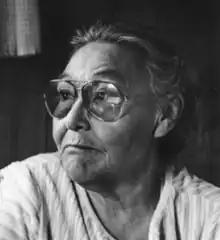Sadie Neakok
Sadie Neakok (March 16, 1916 – June 13, 2004)[1] or Tagiagiña (last name pronounced Niaquq in Iñupiaq) was the first female magistrate in Alaska.[2][3] She served in Alaska's Second Judicial District in Utqiaġvik, Alaska.

Personal life
Her father, Charles D. Brower, was a United States Commissioner in the Alaska territory and her mother, Ahsiangatok (Asiaŋŋataq), was Iñupiaq from the Barrow area.[4][5] Her father originally moved to the Alaska to work as a commercial whaler and was the first white settler there.[5] Neakok was born in 1916.[5] One of ten children, she was sent to San Francisco, California at the age of 14 to attend high school and then attended the University of Alaska.[4][5] After graduation, she worked first in a hospital, and then as a teacher in a Bureau of Indian Affairs school and a social worker.[6][4][5]
She married Nathaniel Neakok, a whaling boat captain[5] who also worked at the Barrow Airport, in 1940 and together they had 13 children and several foster children.[4][5] As of 1989, the couple had been married for over 50 years.[5] Her oldest son, Bill, was mayor of Utqiaġvik (then Barrow) in the 1970s.[4]
She died in 2004. In 1992 Margaret B. Blackman wrote her biography, Sadie Brower Neakok: An Inupiaq Woman.[5]
In 2009, Neakok was inducted into the Alaska Women's Hall of Fame.[7] She was the first woman elder in her Presbyterian church.[5]
Judicial career
She became a magistrate in Alaska's Second Judicial District when the territory gained statehood in 1958.[4] She ran the court in both the English and Iñupiaq languages,[4] and had to fight to allow cases to be heard in the local language when defendants did not speak English.[5] She followed Eben Hopson, who encouraged her to take the position.[6] Before a courthouse was built, she heard cases in her kitchen.[5]
Inuit advocate
As a half Inupiaq, Neakok was an advocate in Alaska and in Washington DC for Inuit causes.[4] As a child, she saw the local Naval base enforcing discriminatory segregation against the native people, inspiring her to defend them.[6] As an adult, she served on the tribal council.[6]
In 1961, in response to what she viewed as an unjust hunting law, she helped organize The Barrow Duck-In.[8][6][5]
References
- "Sadie Neakok". Fold3. Retrieved May 20, 2020.
- "Profiles in Change: Names, Notes and Quotes for Alaskan Women – Sadie Neakok". www.alaskool.org. Retrieved 2018-12-21.
- United States of American Congressional Record. Government Printing Office.
- Burks, Edward C. (December 13, 1971). "Her Court Is on Arctic Shores, Her Cause Is Eskimos' Rights". The New York Times. p. 50. Retrieved May 3, 2020.
- Blackman, Margaret B. (1992). Sadie Brower Neakok: An Inupiaq Woman. University of Washington Press. ISBN 978-0-295-97180-3. Retrieved May 3, 2020.
- "Sadie Neakok". Alaskool. Retrieved May 3, 2020.
- "Sadie Naekok". Alaska Women's Hall of Fame. Retrieved May 3, 2020.
- Burwell, Mitchel. ""Hunger Knows No Law" : Seminal Native Protest and The Barrow Duck-In of 1961" (PDF). Berring Straight School District. Retrieved May 3, 2020.